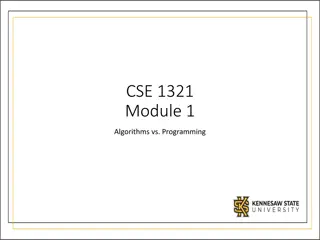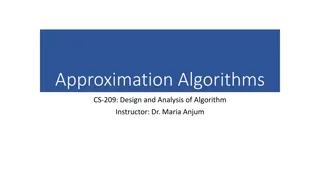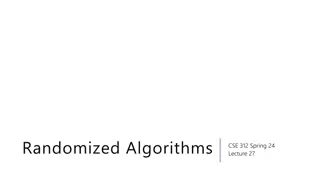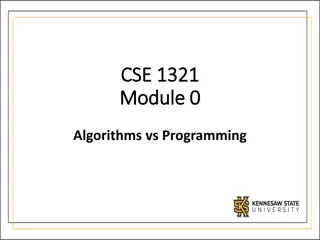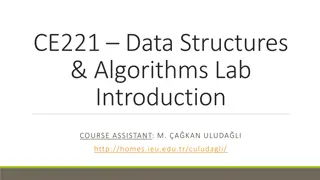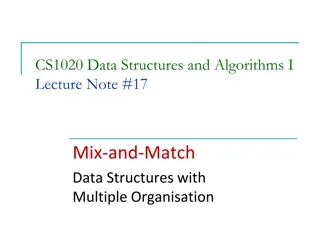Advanced Data Structures and Algorithms at Scale
Explore write-optimized data structures, B-trees, ??-trees, log-structured merge trees, interface operations, and their implementations. Understand node sizes, search operations, updates, buffer additions, batch operations, and more.
Download Presentation

Please find below an Image/Link to download the presentation.
The content on the website is provided AS IS for your information and personal use only. It may not be sold, licensed, or shared on other websites without obtaining consent from the author.If you encounter any issues during the download, it is possible that the publisher has removed the file from their server.
You are allowed to download the files provided on this website for personal or commercial use, subject to the condition that they are used lawfully. All files are the property of their respective owners.
The content on the website is provided AS IS for your information and personal use only. It may not be sold, licensed, or shared on other websites without obtaining consent from the author.
E N D
Presentation Transcript
Write-Optimized Data Structures CS5234 Algorithms at Scale Foo Guo Wei Kuan Wei Heng
Recap B-trees Node size a multiple of B => ?(? ?) leaves => ? log?? tree height pivots B B children pivots pivots B B ?(log??) ? elements elements B B ?leaves
Recap B-trees search ?(log??) amortized pivots B B children pivots pivots B B ?(log??) ? elements elements B B ?leaves
Recap B-trees update ?(log??) amortized Find leaf node to insert into Insert into leaf node Recursively split/share/merge up the tree pivots B B children pivots pivots B B ?(log??) ? elements elements B B ?leaves
Recap ??-trees Addition of a buffer Batch operations Buffer is flushed to children when full B-tree when ? = 1 Buffer tree when ? = 0 buffer ? ?? ?? pivots buffer ? ?? buffer ? ?? ?(log?? ?) ?? ?? pivots pivots ??children ? elements elements B B ?leaves
Recap ??-trees search Dependent on height of tree => ?(log?? ?) buffer ? ?? ?? pivots buffer ? ?? buffer ? ?? ?(log?? ?) ?? ?? pivots pivots ??children ? elements elements B B ?leaves
Recap ??-trees update Updates are batched in buffer Flushed down the tree only when necessary Avoids seeking to leaf node for every update ?(log?? ? ?1 ?) amortized buffer ? ?? ?? pivots buffer ? ?? buffer ? ?? ?(log?? ?) ?? ?? pivots pivots ??children ? elements elements B B ?leaves
Interface Operations insert(k, v) update(k, v) delete(k) get(k) Keys are unique
Implementation Operations insert(k, v) update(k, v) delete(k) get(k) Keys are unique insert/update/delete are blind writes (no check to see if key is in tree)
Implementation Operations insert(k, v) update(k, v) Same as insert delete(k) Implemented by inserting tombstone get(k) Keys are unique insert/update/delete are blind writes (no check to see if key is in tree)
B-Tree writes 1 2 3 4 5 6 7 8
B-Tree writes Update key 6 1 2 3 4 5 6 7 8
Structure of LSM Tree Log-structured : organised into levels Level 0: in main memory Level >0: on disk Each level is k times larger than previous level Keys in a level are unique
Structure of LSM Tree Main memory Level 0 logk (n) levels Level 1 Disk Level 2 Exponentially increasing size
How it works Insert Insert into level 0 When a level is full, merge it into the next level If next level is full, repeat Search Search for key within each level, from top to bottom Return value of first key
Merging Main memory Level 0 is full Disk
Merging Main memory Level 1 is read into memory Disk
Merging Merge while removing duplicate keys Main memory Disk
Merging Main memory Disk Write to disk Reads and writes during merge are done concurrently!
How levels are stored Merging needs to be efficient Nice if searching is also efficient Original paper uses B-Tree Many implementations use SSTable
Sorted String Table (SSTable) Contiguous sequence of key-value pairs Keys are sorted Values are variable-length strings Key Value Key Value ...
SSTable usage Building level 0: Can sort efficiently Can be streamed and merged efficiently Effectively immutable on disk
Search? Keys are sorted but positions unknown Cannot binary search Linear search may have to load entire level into memory
Cache-Oblivious Lookahead Array (COLA) Cache-Oblivious (obviously) Write-Optimized (same performance as buffer tree) ?(log ? ?) update ?(log?) search Intuition same as buffer tree Updates are batched (naturally.. we ll see) Flushed down the tree when necessary, making full use of cache
Cache-Oblivious Lookahead Array Collection of sorted arrays Exponentially increasing in size Arrays either full or empty k-th array contains items iff k-th LSB of N is 1 1 level 0 50 2 level 1 45 78 4 level 2 2? level k ? 2 level log2? 1 => ?(log2?) arrays
Cache-Oblivious Lookahead Array Level Filled 0 1 50 1 1 45 78 N = 11 2 0 3 1 5 8 14 42 56 72 91 99 Notice how this is the binary representation of N
Cache-Oblivious Lookahead Array Insert(6) Insert at level 0 6 Level Filled 0 1 50 1 1 45 78 N = 12 2 0 3 1 5 8 14 42 56 72 91 99 Notice how we basically perform a carry operation
Cache-Oblivious Lookahead Array Insert(6) While 2 arrays of same size exist: Merge Level Filled 0 0 => 6 50 1 1 45 78 N = 12 2 0 3 1 5 8 14 42 56 72 91 99 Notice how we basically perform a carry operation
Cache-Oblivious Lookahead Array Insert(6) While 2 arrays of same size exist: Merge Level Filled 0 0 1 0 => 6 45 50 78 N = 12 2 0 3 1 5 8 14 42 56 72 91 99 Notice how we basically perform a carry operation
Cache-Oblivious Lookahead Array Insert(6) While 2 arrays of same size exist: Merge Level Filled 0 0 1 0 N = 12 2 1 6 45 50 78 3 1 5 8 14 42 56 72 91 99 New binary representation of N
Cache-Oblivious Lookahead Array Amortized Analysis Charging Argument Each level has bank account Every item that enters a level pays ? 1 ?to that level s account ? ? in bank enough to pay for merging 2 sorted arrays Levels with K items has ? There are only log? levels Level Filled 0 0 Conclusion: Cost of insert is ? 1 0 log ? ? N = 12 2 1 6 45 50 78 3 1 5 8 14 42 56 72 91 99
Cache-Oblivious Lookahead Array Search Binary search each level => ? ???2? Level Filled 0 0 1 0 N = 12 2 1 6 45 50 78 3 1 5 8 14 42 56 72 91 99
Cache-Oblivious Lookahead Array Search Binary search each level => ? ???2? Can we do better? (spoiler, yes) Level Filled 0 0 1 0 N = 12 2 1 6 45 50 78 3 1 5 8 14 42 56 72 91 99
Fractional Cascading The lookahead in COLA Idea Restrict search at each level to ?(1) items Jump to relevant section of next level in ? 1 Improved Search Performance ?(log?)
Fractional Cascading Jumping in ? ? Insert lookahead pointers to fixed intervals of the next level Lookahead Pointers Contains pointer to target item Has same logical value as target item Can be compared with (and sorted amongst) other items - + 3 L5 58 L69 72 83 91 99 - + 5 8 14 42 48 53 65 67 69 81 86 88 92 95 97 98 Interval = 8
Fractional Cascading Finding where to jump in ? ? Store duplicate lookahead pointers at fixed intervals of each level Duplicate Lookahead Pointers Points to nearest lookahead pointers on left and right of the same level - + <D> L5 58 L69 <D> 83 91 99 Interval = 4 - + 5 8 14 42 48 53 65 67 69 81 86 88 92 95 97 98 Interval = 8
Fractional Cascading Bookkeeping Overhead Half the space at each level - + <D> L5 58 L69 <D> 83 91 99 Interval = 4 - + 5 8 14 42 48 53 65 67 69 81 86 88 92 95 97 98 Interval = 8
Fractional Cascading Find(92) While current section exist Search current section - + <D> L5 58 L69 <D> 83 91 99 - + 5 8 14 42 48 53 65 67 69 81 86 88 92 95 97 98
Fractional Cascading Find(92) While current section exist Search current section If found, return Else we have located insertion point - + <D> L5 58 L69 <D> 83 91 99 - + 5 8 14 42 48 53 65 67 69 81 86 88 92 95 97 98
Fractional Cascading Find(92) While current section exist Search current section If found, return Else we have located insertion point Use duplicate lookahead pointers to find nearest lookahead pointers - + <D> L5 58 L69 <D> 83 91 99 - + 5 8 14 42 48 53 65 67 69 81 86 88 92 95 97 98
Fractional Cascading Find(92) While current section exist Search current section If found, return Else we have located insertion point Use duplicate lookahead pointers to find nearest lookahead pointers - + <D> L5 58 L69 <D> 83 91 99 - + 5 8 14 42 48 53 65 67 69 81 86 88 92 95 97 98
Fractional Cascading Find(92) While current section exist Search current section If found, return Else we have located insertion point Use duplicate lookahead pointers to find nearest lookahead pointers Search next section - + <D> L5 58 L69 <D> 83 91 99 - + 5 8 14 42 48 53 65 67 69 81 86 88 92 95 97 98
Fractional Cascading Find(92) While current section exist Search current section If found, return Else we have located insertion point Use duplicate lookahead pointers to find nearest lookahead pointers Search next section - + <D> L5 58 L69 <D> 83 91 99 - + 5 8 14 42 48 53 65 67 69 81 86 88 92 95 97 98
COLA Conclusion ?(log ? ?) update ?(log?) search


